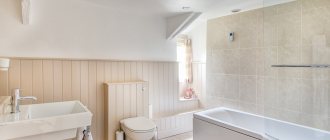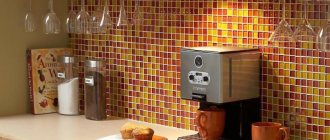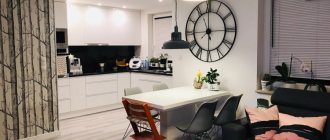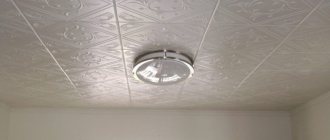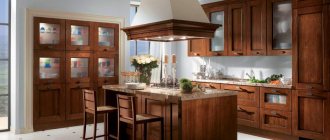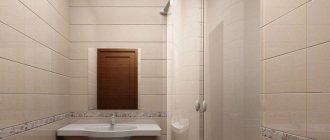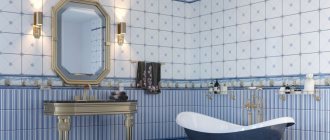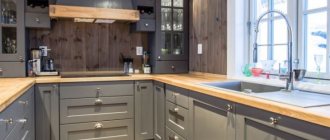Often you have to make repairs in the kitchen and then special attention should be paid to the decoration of the walls. Since in this room you often have to work with water, oil, and various utensils, the surface coating must be durable and wear-resistant. Recently, kitchen decoration with plastic panels has become popular, the photo design of which is presented in the selection. This coating is not only highly durable, but also has an excellent design. In addition, plastic panels with different designs, colors and patterns can be found on sale.
Types of plastic panels for kitchen decoration
Before you start decorating the walls of the kitchen room, you need to choose the appropriate material. The design of plastic panels can be different, the main thing is that it fits into the overall style of the room’s interior. In addition, panels made of a plastic base can be of different types, so you need to know the main features of each type.
Lining
In appearance, the lining is similar to a regular finishing board. It can be used to decorate walls in the kitchen, and can also be used for individual parts, for example, to decorate an apron.
Features of this material:
- dimensional parameters - the width varies from 10 to 12.5 cm, and the length can reach up to 6 meters;
- the design of the lining is often made in the form of wood, but sometimes monochrome coloring is also found;
- high strength - the base feels quite dense and strong to the touch;
- Depending on the size and style of the room, the lining can be installed in different ways - in a horizontal position it is installed in cases where the room needs to be visually expanded. in a vertical position when you need to increase the ceiling height. Also sometimes used is an unusual method of laying diagonal or combined.
Slatted panels
These are plastic panels that are also used to decorate walls in the kitchen. Various photos show how harmonious and beautiful this material looks in the kitchen.
Main features of slatted panels:
- the width size is about 25-50 cm, the length size varies from 2.6 to 3 meters;
- in appearance and method of fastening, slatted panels resemble lining;
- this type of panel is usually attached to the sheathing, and the joints are covered with moldings;
- This type of material is suitable for completely finishing kitchen wall surfaces.
Tile
The design of this material is similar to ordinary tiles. It is produced in the form of square tiles of various sizes.
Features of this type of material:
- the most popular are plastic tiles with sizes from 30x30 cm to 98x98 cm;
- thickness size can range from 8 to 25 mm;
- These plastic material wall tiles are often chosen for backsplash installation;
- The design of this variety may vary. On sale you can find simple classic tiles, and also the imitation of the natural pattern of wood and natural stone looks unusual. Various photos of this material allow you to choose the appropriate appearance of plastic tiles for kitchen decoration;
- To install this material, a lathing is used, which ensures the connection of the tiles using the tongue-and-groove method.
Sheet plastic
Sheet plastic is much longer and wider than tiles, but it has a very thin structure (only 3-6 mm). Since stores provide a wide selection of this type of panel, buyers can always choose the right material. Panels with dimensions of 1.22x2.44 m are in great demand. Panels with these parameters are much more convenient in the finishing process.
After installation, all joints and seams are sealed with adhesive or covered with slatted panels.
User characteristics
The kitchen is a special room. Here the cladding material is subjected to the most severe tests. These include temperature changes, high humidity, the action of steam, and a wide variety of pollutants - from ordinary house dust to indelible food dyes.
The most versatile option is tiling. Ceramics does not absorb moisture and is indifferent to temperature changes. But it also has a drawback: the tile conducts heat well, so the surface of such a wall is always cool, which contributes to the active deposition of steam. As a result, only the kitchen apron is usually tiled.
Plastic panels, despite their low mechanical strength, satisfy all other requirements.
The photo shows panels for interior decoration.
- Moisture resistance - plastic does not interact with water or steam.
- The material is extremely easy to clean from any type of kitchen contaminant. Wall panels can actually be cleaned with just one swipe of a sponge.
- Low thermal conductivity compared to metal and stone. The finish remains warm to the touch, and steam does not condense as intensely.
- Plastic wall panels are dielectric and do not conduct electricity.
- The most varied design. You can choose not only color and shade, but also texture, pattern, ornament, imitation of any natural material, and so on ad infinitum. Modern plastic products are quite capable of imitating metal and mirror surfaces.
- High-quality wall panels are characterized by stable dimensional parameters, which greatly facilitates installation and further use: after installation, the kitchen apron and walls are not deformed.
- Installation of the product is extremely simple: you can do it yourself, without having much experience working with building materials. Wall panels can be mounted on a frame, and if the wall surface is even, they can simply be glued on.
Of course, plastic also has its disadvantages:
- The material can be easily scratched and damaged by a slight blow: the finish does not have high mechanical strength.
- Some types fade under the influence of ultraviolet radiation, but this mainly applies to material whose design is ensured by thermal transfer of the pattern.
- Fire hazard - during production, appropriate components are added to plastic that reduce the ability of the organic material to ignite.
- However, this does not reduce the instability to high temperatures: plastic sheets are deformed and melt from the heat.
Recommendations for selection
When choosing plastic panels for decorating the wall surfaces of a kitchen space, it is important to follow important recommendations:
- the parameters of the plastic material should be slightly larger than the apron area so that it can go behind kitchen cabinets, tables, sinks, and gas stoves;
- if you plan to install plastic panels next to the hob, then it is advisable to purchase a base with high fire resistance;
- design, color schemes - these parameters are selected depending on the size of the kitchen area. Large patterns and dark shades are suitable for spacious rooms, but for rooms with a small area it is worth using a base with small patterns and light colors. The ideal option would be a plain surface or imitation wood with a matte surface;
- for variety, you can purchase unusual panels that are made with a metallized surface for a high-tech style, with a brick surface for a minimalist style, with a wood surface for a classic style, and in an antique style with ornaments and images for a vintage style.
Advantages and disadvantages of PVC panels
Advantages:
- Versatility Suitable for finishing kitchen aprons and walls. To cover the surface above the countertop, choose good quality materials, since it is on the apron that moisture and splashes of oil from the food being prepared come into contact.
- Durability Service life - 10 years.
- Moisture resistance PVC is not afraid of high humidity and is easy to clean.
- Choice of colors Panels are produced both in the form of lining in different colors and in the form of tiles or mosaics. There are also decor options.
Installation of the apron is done in 2-3 hours, and finishing the kitchen with PVC panels will take 1-2 days. This is important if you are making repairs in an apartment in which you live permanently.
Flaws:
- Fragility
The material is easily damaged. This can be partially prevented by making the sheathing in small increments - about 30 cm. - Tendency to rub
Panels should not be washed with steel wool. Otherwise there will be scratches on them.
!
Advice:
Matte panels in the kitchen will last longer than glossy ones, since gloss is more prone to rubbing.
- Susceptibility to deformation
The material may deform due to sudden temperature changes. This applies to the area of the apron adjacent to the slab. - The flammability
of PVC releases toxic substances when burned. Do not install materials of questionable quality near gas stoves.
!
Advice:
The service life of the plastic apron can be extended if a heat-resistant glass screen is installed near the stove on top of the PVC. This way the panels will be protected from high temperatures, open fire, dirt and grease.
Color and pattern
Decorating the walls with plastic panels in the kitchen looks beautiful, original, and unusual. For finishing, you can use different types of panels with different colors and different patterns. To begin with, you can look at photos with the textures of plastic material for finishing wall surfaces; they will help you choose the appropriate base style.
Plastic panels can have a variety of textures:
- various colors - white, yellow, pink, green, blue, brown, red, black and so on;
- the base looks unusual with an imitation of natural material - wood, stone, water and more;
- drawings in the form of flowers, various plants, kitchen attributes, fruits, vegetables will give this room the basic style and make its design original.
Products made from chipboard and laminated chipboard
Another budget option. Despite this, the kitchen apron looks beautiful. The panels are safe and can be easily cleaned from dirt with a damp cloth. But chipboards are afraid of strong temperature fluctuations and high humidity.
If we talk about chipboard, then this is the same board, but with lamination. This is a transparent polymer, this option is better for kitchens, because thanks to the protective layer, moisture does not penetrate into the structure of the material. Through lamination, you can achieve an imitation of natural materials such as stone, wood, brick.
Decorating a kitchen apron
The apron in the kitchen is an important area that gives the main style to this room. First of all, it must be practical and fit into the overall interior of the entire room. In addition, it should be harmoniously combined with all pieces of furniture and complement their style. Be sure to look at the photo with apron design options.
When decorating an apron with plastic material, it is worth considering important features:
- it is important that it protects the wall surface from dirt, dust, splashes of oil, and water;
- Since in this area you often have to cook, fry, and work with water, it is worth choosing a material with high strength. It must also withstand exposure to detergents;
- To decorate your apron, you can choose an unusual design, for example, a base with flowers, kitchen attributes, fruits or vegetables. The main thing is that its overall appearance fits into the interior style of the entire room.
Decor
Manufacturers produce wall panels with decor. The design is applied to plastic using offset printing, thermal printing or lamination.
Thermal printing.
The design is applied using a hot silicone roller. The design is not secured with varnish and is therefore susceptible to damage. Thermally printed panels are recommended for use in rooms and corridors.
The stability of the pattern depends on the method of its application (photo No. 4)
Offset printing.
More stable compared to thermal printing. Ultraviolet paints are used to apply the design. The top of the drawing is covered with several layers of protective varnish. Offset printed panels are resistant to mechanical damage and detergents. Suitable for finishing bathrooms and kitchens.
Lamination.
A painted PVC film is applied to the base. The surface of the panel is embossed. It reliably imitates the surface and texture of wood. The surface is resistant to moisture and detergents. Suitable for finishing bathrooms, kitchens and living rooms.
!
Advice:
It is better not to use laminated panels for finishing the apron, as they have an uneven texture. They are harder to wash.
The wood texture is clearly visible on laminated panels (photo No. 5)
Finishing kitchen surfaces with plastic panels
Before you begin finishing the wall with panels, it is important to first familiarize yourself with the main stages of the work.
Required Tools
To begin with, it is worth purchasing the required amount of material; it is better to purchase a little more so that later you do not need to buy additional panels again. In addition, you will need the necessary equipment for work:
- tape measure;
- a simple pencil;
- mounting type level;
- scissors, stationery knife or hacksaw;
- electric drill, hammer drill.
Tools required for DIY installation of plastic panels
Plastic panels
Accessories for plastic panels
Preparatory work
Before you begin the process of finishing the walls, you should prepare them. To do this, they should be cleaned of the old coating. If there is wallpaper on the walls, then it is worth cleaning it; you can use a spatula for this. If the walls are painted, then use a hammer drill with a special attachment to remove the paint. After this, all uneven areas should be puttied. After drying, everything is sanded. And after that you can begin the finishing itself.
Cleaning walls from old coating
Frame method
To install using this method, you will need slats made of a wooden base or a profile made of a metal or plastic base to make the frame. It is advisable to pre-treat the wooden frame with a special antiseptic impregnation; this will protect it from the effects of high humidity.
How to install the panels:
- wooden planks or metal or plastic panels are attached to the wall surface using self-tapping screws or dowels with nails. The direction of these elements should be perpendicular to the plastic panels;
- all pipes and communications must be bypassed using a frame structure;
- Be sure to use a level when installing the frame structure; all angles must be right;
- the distance between the slats must be at least 50 cm;
Installation of sheathing
- after complete installation of the frame structure, fittings are installed - internal and external corners, as well as final components;
- if you plan to install panels up to the ceiling, then a ceiling-type plinth must be attached to the upper ceiling;
- Installation of panels should begin from the corner. It is necessary to cut off the side groove of the first panel, this will ensure a tight installation to the wall;
Installation of panels on a wooden frame
- then everything is checked using a level, after which the panel is attached using screws and staples;
- the remaining panels are inserted into the grooves and attached to the frame.
Frameless method
Installation of plastic panels using this method is similar to installation of tiles.
The installation process follows the following scheme:
- the surface of the wall should first be leveled and primed;
- Using a notched trowel, you need to apply glue, then install the panel on it and press it;
- all other panels are joined together;
- the outer panels are attached using staples and self-tapping screws.
Liquid nails can be used for fastening
The wall surface is also covered with glue
Wall paneling
PVC elements are joined using the tenon-to-groove principle, which greatly facilitates the work. Finishing the apron or covering all the walls takes very little time.
Installation is done using glue
- First of all, an L-profile is attached to the slats around the perimeter - at the top and bottom.
- A corner profile is installed in the corners.
- Do-it-yourself cladding begins from the corner: the first panel must be placed in the starting profile and pushed into the corner, and then secured: the material is fastened to wood with construction staples, to metal with screws.
The photo shows fastening the material with clamps. - The next panel is inserted into the groove of the previous one and fixed in the same way.
- The last part most often has to be trimmed. Just do this with a regular hacksaw. The trimmed panel is first inserted into the profile, and then into the groove of the previous one.
In the following video, the finishing of kitchen panels is carried out by specialists.
Modern plastic panels are very diverse. With their help, you can make a kitchen design very unusual and original. At the same time, the cost of the material is quite affordable, and even a beginner can handle the installation.
Interesting design ideas
When covering walls with panels, the design of the future coating also plays an important role. It should look beautiful, original, and complement the interior of the entire room. It is advisable to hide all communications and pipes. They can be neatly put away in the sheathing, but they will not disturb the overall appearance of the kitchen. If you plan to hide the wiring, then you should not wall it up tightly. You definitely need to provide access to it; to do this, you can make a small door in the plastic covering to access the wiring.
In addition, when decorating a kitchen space, it is worth remembering a few important tips:
- If the room is small, then you should choose light colors for the wall surface. A light tone will make the room even wider;
- It is not advisable to choose bright colors or large patterns. This style is best used for an apron;
- colors can be combined, but the main thing is that they match. It is better to first look at the photo with the methods of such design;
- The shade of the plastic base can be changed using self-adhesive film. How to do this can be seen in various photos.
Finishing the kitchen with plastic panels is an unusual option to decorate this room in a stylish, original way.
The main thing is to choose the right material so that it is durable, fire-resistant, and wear-resistant. In addition, it must fit into the overall style of the room and be in harmony with all pieces of furniture. Therefore, before you start working on decorating walls with plastic, it is better to look at photos with finishing options.
Other wall panel options
The finishing of kitchen walls with panels is also made from other materials. For example, this is an artificial stone. It has a long service life, the stone is not afraid of mechanical stress and high moisture. The material is natural and does not harm health. It is possible to create an original composition in the kitchen. The disadvantage of the products is the complexity of processing, installation work, high cost and heavy weight.
To make a loft-style kitchen, metal sheet materials are used. The color chosen is grey. Design solutions are also different.
There are wall panels with photo printing. The material for their creation is different. The main thing is that a certain pattern is applied to the surface. It helps make the kitchen beautiful and modern.
